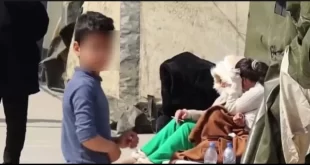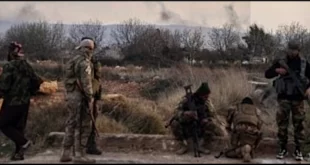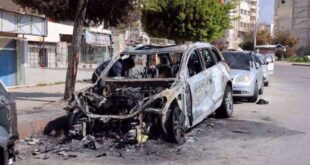 Sep 11, 2013, Foreign Policy
Sep 11, 2013, Foreign Policy
The attack on Syria is off — at least for the moment. So the efforts by Barack Obama’s administration to provide assistance to Syria’s rebels are poised once again to become the focus of beyond-intense scrutiny. And an American whom the Syrian opposition knows as “Mr. Mark” is about to be one of the most important players in the planet’s most important conflict.
Mark Ward is the U.S. State Department’s senior advisor on assistance to Syria, and from his perch across the border in Gaziantep, Turkey, he oversees a growing American assistance package. Much of it is humanitarian aid provided to Syrians in need of help during the civil war. But an enlarging pot of assistance — from packaged meals to pickups — goes to the Syrian opposition’s Supreme Military Council (SMC). Ward has been working out of hotel rooms and warehouses in Gaziantep since last November. With his San Francisco Giants ball cap and the authority of a veteran foreign service officer seasoned in world crises, Ward is the face of American assistance in Syria. He now oversees the $1.2 billion aid package that has flowed or, to some critics, trickled into the country since March 2012.
Assistance to the Syrian opposition, both “lethal” and “nonlethal,” is one thing upon which most people on all sides of the argument about U.S. policy in Syria agree. But it has yet to give rebel forces the upper hand. A great deal of the aid has yet to arrive, in fact. Since the Obama administration announced its plan to up the aid into Syria this spring, the White House has come under fire for how that assistance is creeping its way into the country. Had the administration moved faster to bolster rebel forces, the thinking has gone, it might not be in the predicament in which it now finds itself, scrambling for a Syrian solution in cruise missile strikes or eleventh-hour deals with Moscow.
Tens of millions of dollars of nonlethal assistance was announced in April, and early this summer, the White House said quietly it would also help rebels with direct arms, assigning that role to the CIA. But as FP reported in June, when the administration announced it would begin arming Syrian rebels, only half the nonlethal aid promised by Secretary of State John Kerry in April had actually arrived there.
Critics like Sen. Bob Corker, the Republican of Tennessee who serves as the ranking member of the Senate Foreign Relations Committee, said last week he was “dismayed” at the dismal pace at which the United States has aided the opposition. Corker has pushed the administration to put forward a “viable plan” to bolster rebel forces before those forces fracture all the more and become weakened. Administration officials have variously blamed the delay in getting assistance to Syrian rebel forces on logistics issues and even on Congress, whose notification process some officials said held up the assistance. Others, however, told FP that the State Department was to blame.
The delay, perceived or real, frustrates Ward, too, who himself wishes assistance could be faster. But as he told FP, shipping aid and equipment into Syria too quickly could mean that it goes to the wrong organizations or communities. Experts on Syria who guide Ward and his team on where best to send it tell him to go slowly. “It’s like vetting the end users of our aid to be sure they aren’t bad guys,” he said in an interview with FP during a visit to Washington last week. “Rush it, and you could do real harm.”
And while critics laugh at an effort that supplies packaged meals to rebel forces that need guns and ammo, Ward defends the approach as one that makes sense. Indeed, packaged meals were the best way to start, he said.
Some time ago, Ward offered tens of thousands of “Meals, Ready-to-Eat” (MREs) to the Supreme Military Council’s Salim Idris, as close to a military ally as the United States has right now. At first, Idris complained bitterly. The United States was providing the SMC with these strange packaged meals when what his men needed was real capability: weaponry. But Ward cautioned Idris: The meals, the American told him, were simply an exam for the Syrians. Take them, send them to your forces, Ward said, and good things will come. “I told him that if you essentially pass this test, the government will give you more things,” Ward told the general.
The exam approach has worked, Ward said. Idris built a distribution network for the packaged meals — sending them through a logistics chain while a subcontractor that the State Department has an agreement with monitors the network, taking pictures and sending them back to Ward and other American officials while at the same time training members of the SMC in effective logistics operations. So far, Ward said, he has seen positive results. Idris continues to pass the test, even asking for more MREs. “Is it perfect? No. But it is good enough for a war,” Ward said.
So far, the aid Ward doles out comes from a combination of money from the State Department and the U.S. Agency for International Development. That includes about $1 billion in humanitarian aid and another $250 million committed for the Syrian opposition. Of that later amount, about $140 million has been spent or is “in train,” as assistance officials call it, and has not all been delivered. An additional $27 million is being spent on MREs, medical equipment, communications gear, and trucks. Additional assistance beyond all that is under consideration but, for now, would fall under the balance of the $250 million pot of aid, about $110 million, State officials said.
Ward’s crawl-walk-run approach may offer a road map for moving forward. The current debate about strikes aside, the U.S. government is likely to stay engaged with the Syrian opposition for months if not years to come. Many leaders in Congress, outside analysts, and those in uniform — indeed many inside the administration — have long favored helping the opposition with lethal and nonlethal assistance.
Although the administration has sent over some aid, the assistance hasn’t appeared to make a difference on the battlefield, not even tactically. The CIA’s arming efforts, which are not transparent, are on a small scale. And what nonlethal assistance that has been pushed through hasn’t begun to change the dynamic. Those connected to the effort say the deliberate approach will pay dividends down the road. But there is a move afoot to put the Pentagon in charge of the assistance to the opposition force. That’s something the chairman of the Joint Chiefs of Staff, Gen. Martin Dempsey, who has been vocally skeptical about intervention, is actively pushing for.
Pentagon officials won’t detail what those plans would look like. But if the Defense Department were to begin a more pronounced train-and-equip effort, it would take cues from its training efforts in places like Iraq and Afghanistan, albeit on a smaller scale. And given the need on the ground, rebel forces could be identified and vetted, and such a train-and-equip mission could commence and be ramped up to an appropriate scale relatively quickly.
“The path to the resolution of the Syrian conflict is through a developed, capable, moderate opposition,” Dempsey said last week, as he quietly lobbied for a more “transparent” approach to training and equipping rebel forces.
But before any of that takes form, all the nonlethal assistance, for now, is the focus of effort. Through Ward, the State Department has provided the SMC with 330,000 MREs. But now that nonlethal assistance is expanding. Idris asked for medical supplies and kits for his men that don’t create a large logistical footprint that regime loyalists would notice. So the State Department has provided Idris and his forces more than 500 first-aid kits and three tons of surgical and medical supplies for field clinics. More is coming. Over the next several months, the State Department plans to deliver additional equipment, like commercial trucks and pickups for the military, satellite and radio equipment, laptop computers, and more medical kits, according to a State Department spokesperson in Washington. The State Department would not provide more particulars about the upcoming assistance for fear it would tip the hand of the SMC’s capabilities to the regime.
Meanwhile, few Syrians recognize what the United States is doing inside Syria. Most Syrians complain that the United States is doing very little, spurring a debate among assistance groups and officials about just how to “brand” the assistance the United States is providing. On one hand it may be important for Syrians to see what the United States is doing for them; on another, giving opposition forces an opportunity to build credibility within the country could be a game-changer. Either way, injecting millions of dollars of assistance into such a complex environment has challenges. The rebels haven’t always been organized enough to accept more aid. As Ward puts it, “Getting them to make a decision in a hurry is hard.”
 Syria Support Movement solidarity with the Syrian people
Syria Support Movement solidarity with the Syrian people




